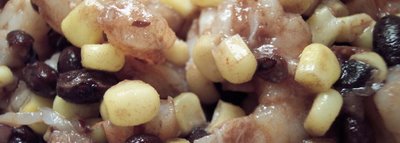
There's something about brownies. They don't carry the Holly Homemaker baggage of cookies (cf. Hillary Clinton: "You know, I suppose I could have stayed home and baked cookies and had teas, but what I decided to do was fulfill my profession."), but they're not fussy either (cf. pastillage).
Inspired by Smitten Kitchen, I decided to experiment with a batch of Cook's Illustrated brownies. As is often the case, I was seized by the urge to bake at an inconvenient time. These things always take longer than you think, so it was 10:30 p.m. before the brownies were anywhere near the cutting stage. After tasting one and declaring it a success, the Human Vacuum got on the phone and called everyone we know in the apartment building. (This was an act of self-defense. An entire pan of brownies in the house only leads to the consumption of an entire pan of brownies unless steps are taken.) Next thing you know, we were hosting a mini brownie party. One visitor arrived sporting pajama pants paired with gold ballet flats. The lesson: Bake it, and they will come.
(A note: Cook's Illustrated is an outstanding magazine. So outstanding, in fact, that when the Human Vacuum and I moved to Boston, I considered applying for a job in their famed America's Test Kitchens. They make 100 pans of brownies to figure out the absolute best technique and ingredients. But before I made much progress on figuring out how to falsify my resume to make it seem like I had two years of restaurant experience, I was struck down by a bout of common sense.)
(Another note: There has been some recent controversy over brownies. From the latest in the "young women are in trouble" genre, Unhooked, by Laura Sessions Stepp: “Tying one on can be fun occasionally. Just don’t let it take over your social life. Organize weekend getaways and other events to bring people together. Bake cookies, brownies, muffins. Ask your girlfriends for assistance. Guys will do anything for homemade baked goods.”)
For more hot brownie action, check out Once Upon a Tart's browniebabe of the month event.
***
Classic Brownies
The recipe is quite involved, as Cook's recipes tend to be, and you can't improve on the directions offered by America's Test Kitchens, so I'm cutting and pasting from my source, Smitten Kitchen. It seems like a lot of work, but the perfect, crackly top and moist dense inside are worth it.
Be sure to test for doneness before removing the brownies from the oven. If underbaked (the toothpick has batter clinging to it) the texture of the brownies will be dense and gummy. If overbaked (the toothpick comes out completely clean), the brownies will be dry and cakey.
1 cup (4 ounces) pecans or walnuts, chopped medium (optional)
1¼ cups (5 ounces) cake flour
½ teaspoon salt
¾ teaspoon baking powder
6 ounces unsweetened chocolate, chopped fine
12 tablespoons (1½ sticks) unsalted butter, cut into six 1-inch pieces
2¼ cups (15¾ ounces) sugar
4 large eggs
1 tablespoon vanilla extract
1. Adjust oven rack to middle position; heat oven to 325 degrees. Cut 18-inch length foil and fold lengthwise to 8-inch width. Fit foil into length of 13 by 9-inch baking dish, pushing it into corners and up sides of pan; allow excess to overhand pan edges. Cut 14-inch length foil and, if using extra-wide foil, fold lengthwise to 12-inch width; fit into width of baking pan in same manner, perpendicular to first sheet. Spray foil-lined pan with nonstick cooking spray.
2. If using nuts, spread nuts evenly on rimmed baking sheet and toast in oven until fragrant, 5 to 8 minutes. Set aside to cool.
3. Whisk to combine flour, salt, and baking powder in medium bowl; set aside.
4. Melt chocolate and butter in large heatproof bowl set over saucepan of almost-simmering water, stirring occasionally, until smooth. (Alternatively, in microwave, heat butter and chocolate in large microwave-safe bowl on high for 45 seconds, then stir and heat for 30 seconds more. Stir again, and, if necessary, repeat in 15-second increments; do not let chocolate burn.) When chocolate mixture is completely smooth, remove bowl from saucepan and gradually whisk in sugar. Add eggs on at a time, whisking after each addition until thoroughly combined. Whisk in vanilla. Add flour mixture in three additions, folding with rubber spatula until batter is completely smooth and homogeneous.
5. Transfer batter to prepared pan; using spatula, spread batter into corners of pan and smooth surface. Sprinkle toasted nuts (if using) evenly over batter and bake until toothpick or wooden skewer inserted into center of brownies comes out with few moist crumbs attached, 30 to 35 minutes. Cool on wire rack to room temperature, about 2 hours, then remove brownies from pan by lifting foil overhang. Cut brownies into 2-inch squares and serve. (Store leftovers in airtight container at room temperature, for up to 3 days.)
.jpg)





































